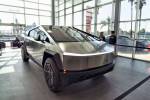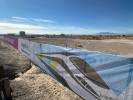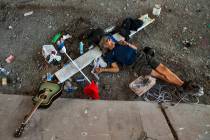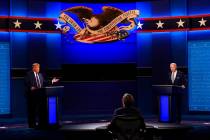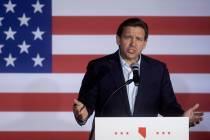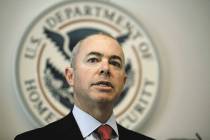On the rail
Back-burnered to some extent by the continuing economic morass, two competing proposals to link Las Vegas to Southern California via high-speed rail still vie for public attention and development subsidies.
The question is how much such a project would really cost per passenger mile, how much of that cost would have to be subsidized by mandatory assessments on taxpayers in Iowa or Alabama who would enjoy no direct benefit, and what percentage of passengers delivered by such a wonder would actually represent new business.
In an analysis of such projects in the Oct. 1 edition of USA Today, Randal O’Toole, a senior fellow with the Cato Institute and author of the book “Gridlock: Why We’re Stuck in Traffic and What to Do About It,” concludes: “We can’t afford the luxury of high-speed rail.”
Late in September, Amtrak proposed to spend more than $100 billion to increase the top speeds of its Boston-to-Washington trains from 150 to 220 mph, Mr. O’Toole reports. In August, Secretary of Transportation Ray LaHood estimated President Obama’s proposal to extend high-speed rail to other parts of the country will cost at least $500 billion.
Which maxed-out credit card do they plan to use?
And while President Obama argues high-speed rail will have a “transformative effect” on the American economy, “In fact, all it will do is drag the economy down,” Mr. O’Toole concludes.
Why? Because high-speed rail is “slower than flying, less convenient than driving, and far more expensive than either one,” the Cato scholar argues.
Amtrak brags that its high-speed Acela between Boston and Washington covers its operating costs (not its capital costs, which were a gift from taxpayers in Nevada and Alaska to the wealthy bankers and lobbyists who ride those club cars). To do even that much, however, Amtrak must collect fares of about 75 cents per passenger mile.
By comparison, airline fares average only 13 cents a passenger mile, while intercity buses (which still carry about three times as many passengers between Boston and Washington as the Acela) “are even less expensive.” Federal Highway Administration numbers reveal the average cost of driving from Los Angeles to Las Vegas in a private car works out to less than 15 cents a passenger mile.
“In short, high-speed rail is more than five times more expensive than any of the alternatives,” Mr. O’Toole concludes.
The final nail in the “does-this-make-economic-sense” coffin? The California High-Speed Rail Authority predicts 98 percent of its customers will shift from driving or flying. Florida predicts that 96 percent of the people using its planned high-speed train would switch from driving. Which means most of that travel will not be new travel, but merely a substitute for driving, flying or something else.
New customers? Where?



